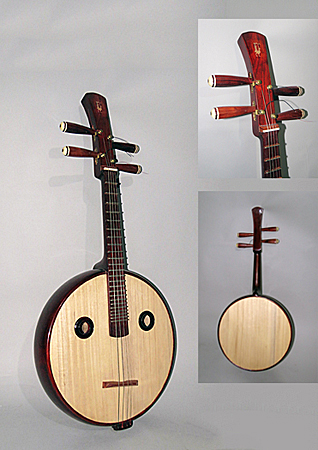
Owner: HWMC
Catalog#: 2AS-CHLT-36
Lutes
Chinese 'Ruan' (Zhongruan)
China / Taiwan
Chinese / Taiwanese
Wood, bone, metal, steel strings,
Late 20th century
Length: 36 in, Diameter: 15.75 in, Depth: 3.25 in
Chordophones – Lutes
The earliest form of the ruan may be the qin pipa (秦琵琶), that developed into the ruanxian (named after Ruan Xian, 阮咸), then shortened to ruan (阮). It is a plucked lute (chordophone) with a fretted neck, a circular body, and four strings. Today the modern ruan comes in a family of five sizes:
Soprano: Gaoyinruan (高音阮, lit. “high pitched ruan”)
Alto: Xiaoruan (小阮, lit. “small ruan”)
Tenor: Zhongruan (中阮, lit. “medium ruan”)
Bass: Daruan (大阮, lit. “large ruan”)
Contrabass: Diyinruan (低音阮, lit. “low pitched ruan”)
This modern 20th century ruan is a tenor, called the zhongruan (“medium ruan”). The neck and sides are made from mahogany stained wood, and the front and back of the body are carved from light unstained wood. The strings are metal, and the tuning pegs have metal mechanisms attached to the long teardrop shaped wooden handles tipped with carved bone. Above the tuning pegs is a stylized bird design inlaid in mother-of-pearl, which leads me to believe this Zhongruan possibly was made in Taiwan. There are 24 wooden frets topped with metal and a mahogany stained bridge. The strings end in a tailpiece at the bottom of the instrument. The body is circular, and on either side of the strings are 2 acoustic holes rimmed with stained mahogany wood. The zhongruan is usually played with a plectrum (guitar pick). It can also be played with fingers (index finger and thumb with acrylic nails), which is similar to the way of playing the pipa (琵琶).
The ruan is now most commonly used in Chinese opera and the Chinese orchestra. In Chinese orchestras, only the zhongruan and daruan are used, to fill in the tenor and bass section of the plucked string section. Occasionally the gaoyinruan is used to substitute the high-pitched liuqin.
Reference: Myers, John (1992). The way of the pipa: structure and imagery in Chinese lute music. Kent State University Press. pp. 5–7. ISBN 9780873384551.
